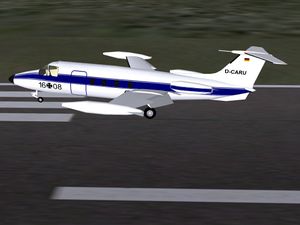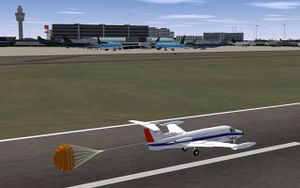Hamburger Flugzeugbau HFB 320 Hansa Jet
 | |
|---|---|
 Deutsche Luftwaffe Hansajet | |
| Type | Business aircraft, Military utility aircraft |
| Configuration | Low wing aircraft, Forward-swept wing aircraft |
| Propulsion | Twinjet (Jet aircraft, Twin-engine aircraft) |
| Manufacturer | Blohm & Voss, Hamburger Flugzeugbau |
| Author(s) | Torsten Dreyer |
| FDM | JSBSim |
| --aircraft= | Hansajet |
| Status | Beta |
| FDM |
|
| Systems |
|
| Cockpit |
|
| Model |
|
| Development | |
| Website |
|
| Repository |
|
| Download |
|
| License | GPLv2+ |
|
| |

The Hamburger Flugzeugbau HFB 320 Hansa Jet was a West German passenger and multi-purpose aircraft developed in the 1960s, powered by two turbojets.[1]
It did not have thrust reversers but a drag chute installed to land on short fields.
Aircraft help
Startup
A tutorial exists for starting up the engines. This tutorial describes and performes all necessary items to get the engines running.
- Pull the throttle levers to CUTOFF (fully back)
- LH and RH WING-PUMP MAIN both ON, located at the overhead panel
- check FUEL PRESSURE LOW lights OFF in the warning panel
- Click START LH and START RH, engines spool up
- Advance throttles to IDLE (a little more than 10%), check IGNITION lights in overhead panel ON
- engines fire and after a few seconds check IGNITION lights are OFF in overhead panel
- check engine rpm approx 50%
- switch on GEN1 and GEN2, warning lights in the warning panel go off
Using the Autopilot
Don't use FlightGear's built in autopilot dialog. It does not work for the Hansajet.
During takeoff, after passing 500ft GND, engage the autopilot by pressing CTRL-A or flipping the AFCS-ENG switch. This will enable HDG HOLD and PITCH HOLD and causing the Hansa to maintain the current magnetic heading and pitch attitude. It is recommended to also activate the yaw-damper. Note: the autopilot only engages if the current bank angle is less than 6 degrees.
Using the PITCH Switch, adjust the pitch attitude of the aircraft. Flipping the switch forward decreases pitch (nose-down), flipping the switch back increases pitch (nose-up). The pitch change is proportional to the duration of the activation of the switch and changes at the rate of one degree per second.
Pressing the ALT mode selector button activates altitude hold. The aircraft will maintain the altitude it was at the moment ALT was pressed. ALT mode is canceled by operating the PITCH switch or disengaging the autopilot.
The TURN rotary knob is for performing turns. Turn the knob clockwise for right turns and counterclockwise for left turns. The rotation of the knob is proportional to the target bank angle of the jet with a maximum bank angle limited to 30 degrees.
Pressing the HDG SEL mode selector switch activates the heading bug. In this mode, the pilot commands the target heading by setting the heading bug in the HSI.
Note: Radio navigation is not yet implemented and the Three-Axis-Trim-Indicators are not yet functional.
Development status/Issues/Todo
- The autopilot is stable but (still) incomplete
- High altitude performance is unrealistic
- Electrical system is incomplete
- Hydraulic system is incomplete
- Weather radar is missing
- Many more
External links
- Photo (airliners.net)
- Gallery of Luftwaffe HFB 320 (wikimedia.org) at the Luftwaffe Museum Berlin-Gatow.
References
|